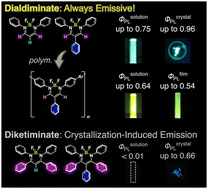Highly efficient luminescence from boron β-dialdiminates and their π-conjugated polymers in both solutions and solids: significant impact of the substituent position on luminescence behavior†
Abstract
Four-coordinated boron complexes are fascinating scaffolds for achieving functional luminescent materials because of their superior emission properties, biocompatibility, and stimuli responsiveness. This class of complexes occasionally exhibits aggregation- or crystallization-induced emission (AIE or CIE) properties in contrast to typical organic chromophores which show aggregation-caused quenching (ACQ). However, in some cases, slight structural modification of the complexes results in drastic changes between AIE/CIE and ACQ. Therefore, there is much room for unveiling the structure–property relationships of this class of complexes. Herein, we developed β-dialdiminate boron complexes with highly efficient fluorescence not only in crystalline states but also in the solution and amorphous states. In stark contrast, we previously reported that β-diketiminate boron complexes exhibit the CIE properties. The structural difference between them is characterized only by the substituents on the imine carbons. Theoretical calculations suggest that the excitons of the β-diketiminate complexes in solutions could be quenched through large structural deformation connecting to conical intersections, while the β-dialdiminate structures could expel such structural changes. Importantly, the absolute photoluminescence quantum yields of the β-dialdiminate boron complexes are up to 96% for crystals, 75% for solutions, 83% for amorphous films, and 76% in a polymer matrix. We applied these robust luminophores to fabricate organic light-emitting devices and to synthesize π-conjugated polymers with strong fluorescence in solutions and films. Our findings can unlock opportunities for designing new robustly luminescent materials based on chromophores which have been used only in either solution or solid states until now.



 Please wait while we load your content...
Please wait while we load your content...